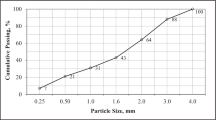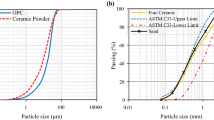Abstract
In this experimental study, the effects of using nano-sized Cement Kiln Dust (CKD) as a partial replacement for Ordinary Portland Cement (OPC) on the strength of cement mortars is investigated. The CKD was milled up to 4 hours in a planetary ball mill. In addition to the control cement mortar mixture with 0% CKD, a total of 28 concrete mortar mixtures were prepared with four different replacement percentages of nano-CKD (5, 10, 15, and 20 %), and seven different milling times (1, 1.5, 2, 2.5, 3, 3.5, and 4 hours). The compressive strengths of all cement mortar mixtures were evaluated after curing periods of 7, 28, and 56 days. In addition, the chemical, physical and microscopical properties of the nano-CKD were evaluated using Scanning Electron Microscope (SEM), Transmission Electron Microscope (TEM) and X-ray diffraction (XRD). The experimental results showed that the partial replacement of the OPC with the nano-CKD enhanced the compressive strength of the cement mortar by about 15-30% compared with normal mortar without CKD. Moreover, the experimental results indicated that no change was observed in the chemical composition of CKD after 4 hours of milling. However, there was a decrease in the Portlandite content in parallel with an increase in the density and the surface area.
Similar content being viewed by others
References
Al-Jabri, K., Hago, A., Taha, R., Alnuaimi, A., and Al-Saidy, A. (2009). “Strength and insulating properties of building blocks made from waste materials.” J. Mater. Civ. Eng., Vol. 21, Issue 5, pp. 191–197, DOI: 10.1061/(ASCE)0899-1561(2009)21:5(191).
Al-Jabri, K. S. and Shoukry, H. (2014). “Use of nano-structured waste materials for improving mechanical, physical and structural properties of cement mortar.” Constr. and Build. Mat., Vol. 73, pp. 636–644.
ASTM (2016). Standard Practice for Making and Curing Concrete Test Specimens in the Laboratory, C192/C192M-16.
ASTM (2016). Standard test method for compressive strength of hydraulic cement mortars, C109M-16.
Bonder, D. and Coakley, E. (2014). “Use of gypsum and CKD to enhance early stage strength of High Volume Fly Ash (HVFA) pastes.” Constr. and Build. Mat., Vol. 71, 93–108.
Colangelo, F. and Cioffi, R. (2013). “Use of cement kiln dust, blast furnace slag and marble sludge in the manufacture of sustainable artificial aggregates by means of cold bonding palletization.” Materials, Vol. 6, pp. 3139–3159.
Ebrahimi, A., Edil, T., and Son, Y. (2012). “Effectiveness of cement kiln dust in stabilizing recycled base materials.” J. Mater. Civ. Eng., pp. 1059–1066, DOI: 10.1061/(ASCE)MT.1943-5533.0000472,.
European concrete platform, Sustainable benefits of concrete structures, Brussels, Belgium 2009.
Hassan, H., Abdul-Kareem, O. M., and Shihab, A. Y. (2013). “Utilization of Cement Kiln Dust (CKD) as a partial replacement of cement in mortar and concrete. Al-Rafidain Eng., Vol. 21, No. 6, pp. 72–87.
Hosseini, P., Mohamad, M. I., Nekooie, M. A., Taherkhani, R., and Booshehrian, A. (2011). “Toward green revolution in concrete industry: The role of nanotechnology (A review).” Australian J. of Basic and Applied Science, Vol. 5, No. 12, pp. 2768–2782.
Huang, C. P. (2006). “The chemistry and physics of nano-cement.” Journal of cement powder, university of Delaware.
Ibrahim, R. K. and Ahmed, F. R. (2015). “The effect of nano-silica in compensating the strength loss caused by using high volume fly ash in high strength mortars.” International J. Engg. Sci. Innov. Tech., Vol. 4, No. 2, pp. 232–241.
Ji, T. (2005). “Preliminary study on the water permeability and microstructure of concrete incorporating nano-silica.” Cement and Concrete Research, Vol. 35, pp. 1943–1947.
Kunal, Siddique, R., Rajor, A., and Singh, M. (2016). “Influence of bacterial-treated cement kiln dust on strength and permeability of concrete.” J. Mater. Civ. Eng., Vol. 28, Issue 10, pp. 04016088, DOI: 10.1061/(ASCE)MT.1943-5533.0001593.
Kuo, W. T., Lin, K. L., Chang, W. C., and Luo, H. L. (2006). “Effects of nano-materials on properties of waterworks sludge ash cement paste.” Eng. Chem., Vol. 12, No. 5, pp. 702–709.
Li, H., Gang, X. H., Yuan, J., and Ou, J. (2004). “Microstructure of cement mortars with nano-particles.” Composite, Part B, Vol. 35, pp. 185–189.
Li, H., Xiao, H., and Ou, J. P. (2004). A study on mechanical and pressure-sensitive properties of cement mortar with nanophase materials.” Cement and Concrete Research, Vol. 34, pp. 435–438.
Lin, D. F., Luo, H. L., and Ye, M. Q. (2005). “The application of nanomaterials to recycle concrete.” Proceeding of the Conf., Kaohsiung Country, Taiwan, pp. 1–18.
Lu, G. and Wang, K. (2011). “Theoretical and experimental study on shear behavior of fresh mortar.” Cem. Conc. Compos., Vol. 33, pp. 319–326.
Maslehuddin, M., Al-Amoudi, O., Rahman, M., Ali, M., and Barry, M. (2009). “Properties of cement kiln dust concrete.” Constr. and Build. Mat., Vol. 23, No. 6, pp. 2357–2361.
Najim, K. B., Al-Jumaily, I., and Atea, A. M. (2016). “Characterization of sustainable high performance/self-compacting concrete produced using CKD as a cement replacement.” Constr. and Build. Mat., Vol. 103, pp. 123–129.
Najim, K. B., Mahmod, Z. S., and Atea, A. M. (2014). “Experimental investigation on using Cement Kiln Dust (CKD) as a cement replacement material in producing modified cement mortar.” Constr. and Build. Mat., Vol. 55, No. 2014, pp. 5–12.
Peethamparan, S. and Olek, J. (2008). “Study of the effectiveness of cement kiln dusts in stabilizing Na-Montmorillonite clay.” J. Mater. Civ. Eng., Vol. 20, Issue 2 pp. 137–146, DOI: 10.1061/(ASCE)0899-1561(2008)20:2(137).
Sariosseiri, F., Razavi, M., Carlson, K., and Ghazvinian, B. (2011). “Stabilization of soils with portland cement and CKD and application of CKD on slope erosion control.” Geo-Frontiers, 2011, pp. 778–787.
Siddique, R. (2006). “Utilization of Cement Kiln Dust (CKD) in cement mortar and concrete.” Resources, Conservation and Recycling, Vol. 48, Issue 4, pp. 315–338.
Siddique, R. (2014). “Utilization of industrial by-products in concrete.” Procedia Eng., Vol. 95, pp. 335–347.
Taha, R., Al-Rawas, A., Al-Harthy, A., and Qatan, A. (2002). “Use of cement bypass dust as filler in asphalt concrete mixtures.” J. Mater. Civ. Eng., Vol. 14 Issue 4, pp. 338–343, DOI: 10.1061/(ASCE)0899-1561(2002)14:4(338).
Udoeyo, F. and Hyee, A. (2002). “Strengths of cement kiln dust concrete.” J. Mater. Civ. Eng., Vol. 14, Issue 6, pp. 524–526, DOI: 10.1061/(ASCE)0899-1561(2002)14:6(524).
Wang, X. and Tan, X. Y. (2000). “Analysis on toughening mechanisms of ceramic nano-composites.” J. Ceram., Vol. 2, pp. 107–111.
Xijun, W. and Mingwen, Z. (1997). “Properties and interfacial microstructures for nanostructure materials.” Chin J. Atomic Mol. Phys., Vol. 2, pp. 148–152.
Ye, Q., Zhang, Z. N., Chen, R. S., and Ma, C. C. (2003). “Interaction of nano-silica with calcium hydroxide crystals at interface between hardened cement paste and aggregate.” Journal of the Chinese Ceramic Society, Vol. 31, No. 5, pp. 517–522.
Author information
Authors and Affiliations
Corresponding author
Rights and permissions
About this article
Cite this article
Alnahhal, W., Taha, R., Al-Nasseri, H. et al. Effect of Using Cement Kiln Dust as a Nano-Material on the Strength of Cement Mortars. KSCE J Civ Eng 22, 1361–1368 (2018). https://doi.org/10.1007/s12205-017-0010-6
Received:
Revised:
Accepted:
Published:
Issue Date:
DOI: https://doi.org/10.1007/s12205-017-0010-6




